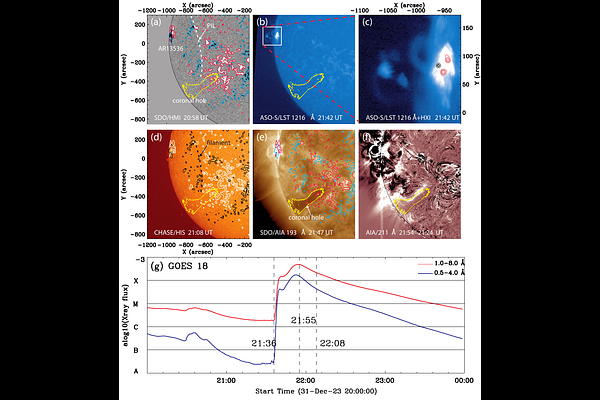Responses of a Coronal Hole to a Fast Flare-Driven Coronal Wave

Responses of a Coronal Hole to a Fast Flare-Driven Coronal Wave
Xiaofan Zhang, Huadong Chen, Guiping Zhou, Li Feng, Yang Su, Jinhan Guo, Leping Li, Wei Lin, Suli Ma, Yuandeng Shen, Ruisheng Zheng, Suo Liu, Xianyong Bai, Yuanyong Deng, Jingxiu Wang
AbstractCoronal waves, significant solar phenomena, act as diagnostic tools for scientists studying solar atmosphere properties. Here, we present a novel observation detailing how a coronal wave event, associated with an X5.0 class flare, influenced the properties of an adjacent coronal hole through interaction. The coronal wave was observed in both extreme ultraviolet observations from the Atmospheric Imaging Assembly aboard the Solar Dynamics Observatory and Lyman-alpha observations from the Solar Disk Imager aboard the Advanced Space-based Solar Observatory. Utilizing the method of differential emission measure, we found that as the coronal wave passed through, the adjacent coronal hole experienced an increase in temperature from 1.31 to 1.43 MK and a rise in density from $\sim$1.62$\times10^{8}$ to 1.76$\times10^{8}$ cm$^{-3}$ within the rising period of $\sim$7 minutes. Subsequently, after the wave passed, the entire coronal hole transitioned to a new state with a slight temperature increase and a 14$\%$ decrease in density, with more pronounced changes observed at the coronal hole's boundary. Taking into account the impacts of radiative loss and heat conduction, the coronal wave was estimated to provide an average energy of 2.2$\times10^{8}$ erg cm$^{-2}$ to the coronal hole during the short rising period. This study highlights the identification of the coronal wave in both extreme ultraviolet and Lyman-alpha observations, shedding light on the significant energy input, particularly within the coronal hole. These findings provide new insights into better understanding kinematics of fast coronal waves, energy transfer processes open versus closed magnetic topologies, and the possible acceleration of solar winds.